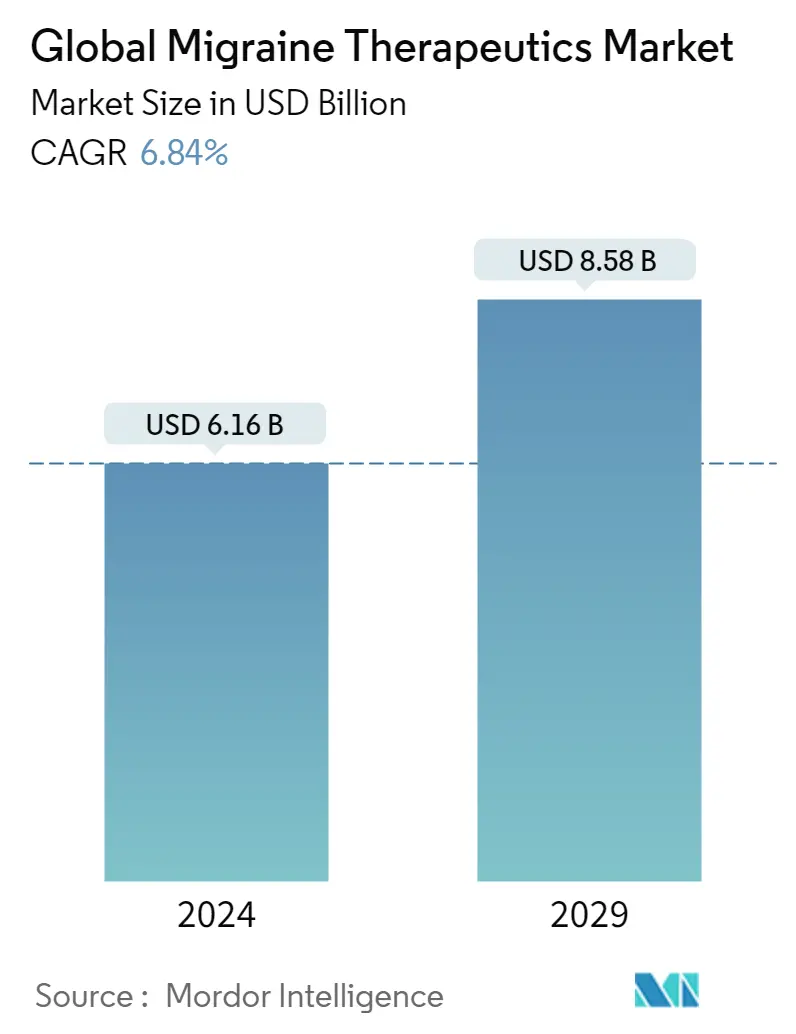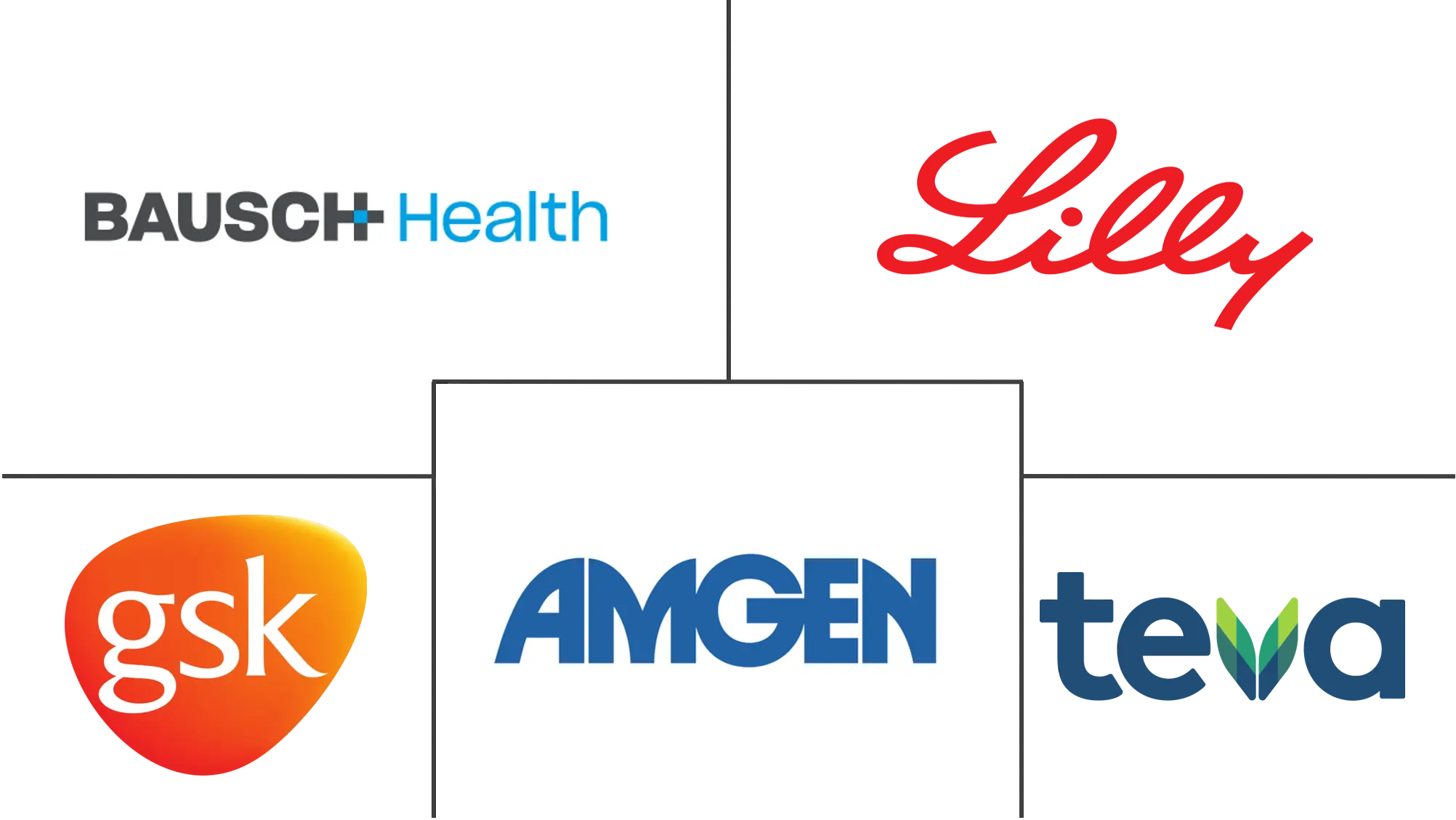Market Size of Global Migraine Therapeutics Industry

| Study Period | 2019 - 2029 |
| Market Size (2024) | USD 6.16 Billion |
| Market Size (2029) | USD 8.58 Billion |
| CAGR (2024 - 2029) | 6.84 % |
| Fastest Growing Market | Asia Pacific |
| Largest Market | North America |
Major Players
*Disclaimer: Major Players sorted in no particular order |
Need a report that reflects how COVID-19 has impacted this market and its growth?
Migraine Therapeutics Market Analysis
The Global Migraine Therapeutics Market size is estimated at USD 6.16 billion in 2024, and is expected to reach USD 8.58 billion by 2029, growing at a CAGR of 6.84% during the forecast period (2024-2029).
COVID-19 was a global public health crisis, and it impacted almost every industry, and its long-term effects were expected to affect industry growth over the forecast period. According to the study titled "Impact of COVID-19 pandemic on migraine management in the United States: insights from migraine tracking app users" published in BMC neurology in September 2021, although the number of migraine attacks decreased, the proportion of stress-related migraine attacks peaked at 53% during COVID-19. Also, the study titled "COVID-19 and Headache Medicine: A Narrative Review of NonSteroidal AntiInflammatory Drug (NSAID) and Corticosteroid Use" published in July 2021, reported that there may be an increase in the number of patients with headaches as their primary complaint during the COVID19 pandemic. Hence, COVID-19 had a significant impact on the migraine therapeutics market.
Growing awareness about migraine and treatment options, rising R&D spending leading to massive pipeline products, and an increase in the prevalence of migraines with high unmet needs are all contributing to the global growth of the migraine therapeutics market.
The various strategic activities by the key market players, such as product launches and product approvals, as well as mergers and acquisitions, boost the market over the forecast period. For instance, in March 2022, AbbVie reported a positive phase 3 progress trial evaluating atogepant (QULIPTA in the United States) for the preventive treatment of chronic migraine in adults. It is an oral calcitonin gene-related peptide (CGRP) receptor antagonist (gepant). In the trial, the drug met its primary endpoint of a statistically significant reduction from baseline in mean monthly migraine days compared to placebo, for both the 60 mg once daily (QD) and 30 mg twice daily (BID) doses, across the 12-week treatment period.
Additionally, in September 2021, the United States Food and Drug Administration (FDA) approved QULIPTA (atogepant) to AbbVie for the prevention of episodic migraine in adults. QULIPTA is one of the world's first and only oral calcitonin gene-related peptide (CGRP) receptor antagonists (gepant) developed specifically for migraine prevention.
Thus, the market is expected to project growth over the forecast period. However, the growth of the migraine therapeutics market may be hampered due to a lack of proper diagnosis, undiagnosed cases, and drug side effects over the forecast period.
Migraine Therapeutics Industry Segmentation
As per the scope of the report, migraine is a complex neurological condition characterized by frequent headaches that can last from 4 to 72 hours. The pain is often unilateral and pulsating in nature, which can often be worsened by physical activity. In most cases, migraine is associated with symptoms such as photophobia, phonophobia, osmophobia, nausea, vomiting, loss of appetite, and sometimes sensory disturbances. The Migraine Therapeutics Market is segmented by Therapeutics (Pain-relieving Medications (Analgesics, Triptans, Ergot Alkaloids, Others), and Preventive Medications (Blood pressure-lowering Medications, Anticonvulsant Drugs, Calcitonin Gene-related Peptide (CGRP) Antagonists, Other Preventative Therapies)), Route of Administration (Oral & Nasal and Injectables), and Geography (North America, Europe, Asia-Pacific, Middle East & Africa, and South America). The report also covers the estimated market sizes and trends for 17 countries across major regions globally. The report offers the value (in USD million) for the above segments.
| By Therapeutics | ||||||
| ||||||
|
| By Route of Administration | |
| Oral & Nasal | |
| Injectables |
| Geography | ||||||||
| ||||||||
| ||||||||
| ||||||||
| ||||||||
|
Global Migraine Therapeutics Market Size Summary
The migraine therapeutics market is poised for significant growth over the forecast period, driven by increasing awareness of migraine conditions, advancements in research and development, and a rising prevalence of migraines with substantial unmet medical needs. The market is characterized by strategic activities from key players, including product launches, approvals, and mergers and acquisitions, which are expected to propel market expansion. Notable developments include the positive trial results and regulatory approvals for innovative treatments such as AbbVie's atogepant and Eli Lilly's REYVOW, which highlight the ongoing innovation in migraine therapeutics. Despite the promising growth trajectory, challenges such as undiagnosed cases and potential drug side effects may pose hurdles to market advancement.
North America is anticipated to maintain its dominance in the migraine therapeutics market, supported by a high prevalence of migraines and the adoption of novel therapeutic options, particularly in the United States. The region's market growth is further bolstered by strategic initiatives from major players, including product approvals and new drug launches. The market landscape is moderately fragmented, with numerous local and international players employing various growth strategies to enhance their market presence. Key companies such as Amgen, Teva Pharmaceutical, and GlaxoSmithKline are actively involved in expanding their portfolios through partnerships, collaborations, and geographical expansions, contributing to the overall dynamism of the market.
Global Migraine Therapeutics Market Size - Table of Contents
-
1. MARKET DYNAMICS
-
1.1 Market Overview
-
1.2 Market Drivers
-
1.2.1 Growing Awareness about Migraine and its Treatment Options
-
1.2.2 Increasing R&D Expenditures Leading to High Pipeline Products
-
1.2.3 Increasing Prevalence of Migraines along with High Unmet Needs
-
-
1.3 Market Restraints
-
1.3.1 Adverse Effects of Drugs
-
1.3.2 Lack of Proper Diagnosis and Increasing Undiagnosed Cases
-
-
1.4 Porter's Five Forces Analysis
-
1.4.1 Threat of New Entrants
-
1.4.2 Bargaining Power of Buyers/Consumers
-
1.4.3 Bargaining Power of Suppliers
-
1.4.4 Threat of Substitute Products
-
1.4.5 Intensity of Competitive Rivalry
-
-
-
2. MARKET SEGMENTATION (Market Size by Value - USD million)
-
2.1 By Therapeutics
-
2.1.1 Pain-relieving Medications
-
2.1.1.1 Analgesics
-
2.1.1.2 Triptans
-
2.1.1.3 Ergot Alkaloids
-
2.1.1.4 Others
-
-
2.1.2 Preventive Medications
-
2.1.2.1 Blood pressure-lowering Medications
-
2.1.2.2 Anticonvulsant Drugs
-
2.1.2.3 Calcitonin Gene-related Peptide (CGRP) Antagonists
-
2.1.2.4 Other Preventative Therapies
-
-
-
2.2 By Route of Administration
-
2.2.1 Oral & Nasal
-
2.2.2 Injectables
-
-
2.3 Geography
-
2.3.1 North America
-
2.3.1.1 United States
-
2.3.1.2 Canada
-
2.3.1.3 Mexico
-
-
2.3.2 Europe
-
2.3.2.1 Germany
-
2.3.2.2 United Kingdom
-
2.3.2.3 France
-
2.3.2.4 Italy
-
2.3.2.5 Spain
-
2.3.2.6 Rest of Europe
-
-
2.3.3 Asia-Pacific
-
2.3.3.1 China
-
2.3.3.2 Japan
-
2.3.3.3 India
-
2.3.3.4 Australia
-
2.3.3.5 South Korea
-
2.3.3.6 Rest of Asia-Pacific
-
-
2.3.4 Middle-East and Africa
-
2.3.4.1 GCC
-
2.3.4.2 South Africa
-
2.3.4.3 Rest of Middle-East and Africa
-
-
2.3.5 South America
-
2.3.5.1 Brazil
-
2.3.5.2 Argentina
-
2.3.5.3 Rest of South America
-
-
-
Global Migraine Therapeutics Market Size FAQs
How big is the Global Migraine Therapeutics Market?
The Global Migraine Therapeutics Market size is expected to reach USD 6.16 billion in 2024 and grow at a CAGR of 6.84% to reach USD 8.58 billion by 2029.
What is the current Global Migraine Therapeutics Market size?
In 2024, the Global Migraine Therapeutics Market size is expected to reach USD 6.16 billion.

